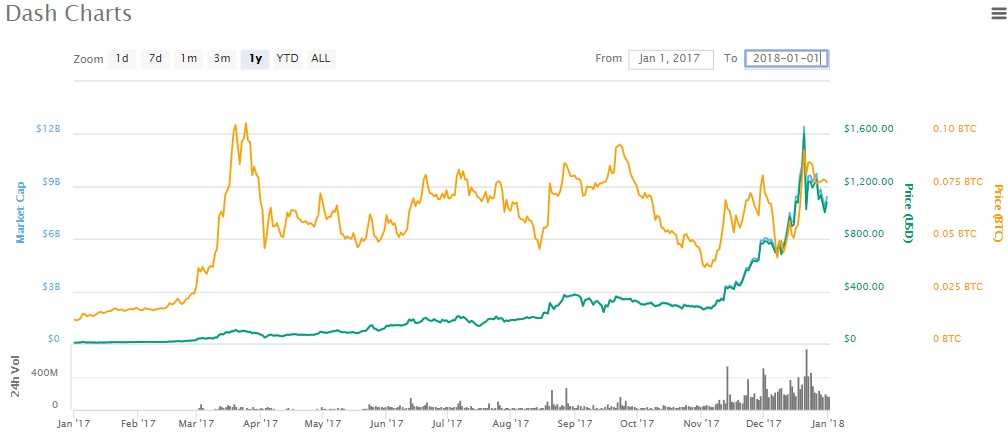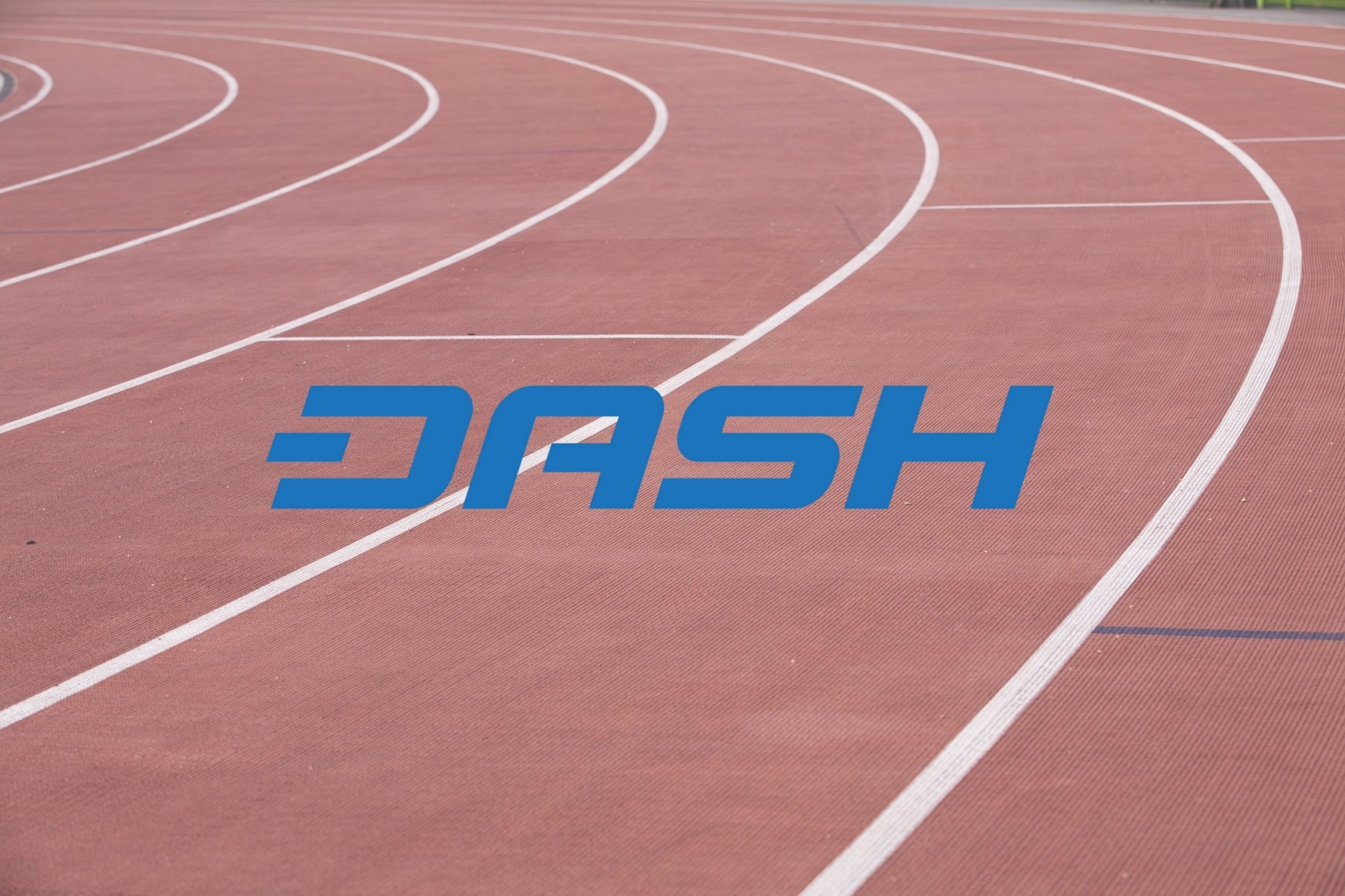The fiercest of battles in the market occur among those coins that seek to become the favored medium of exchange and a convenient choice for daily transactions. Bitcoin, the runaway leader in this match so far, must constantly evolve to fend off the newer species of coins which lack the already claimed territory of Bitcoin but benefit from software advantages and innovations pre-programmed from the start.
Mainstream adoption is a universal challenge in the cryptocurrency market, but for those coins functioning as a medium of exchange, it is particularly difficult. Unlike other coins, which either target developers, businesses or other specific groups, coins like Bitcoin and Dash target the general population – which is unpredictable, finicky and, as the recent rollercoaster ride of the market has shown, easily spooked.
Among these coins is Dash. Currently 13th largest by market cap, this cryptocurrency initially attempted to find use as a privacy coin. It has since transformed itself into a primarily payments-focused coin and has been plugging away at achieving mainstream adoption ever since. It has several distinctions that separate it from Bitcoin and if you’d like a thorough guide to the the project, read our introduction to Dash.

Dash grew substantially in 2017, gaining 100x in value as it began 2017 with at $11 and ended it at approximately $1,100. This was not simply because of the hyperbolic boom the market was subject to in 2017; the project’s development was a key factor as well. At the time of writing, Dash is valued at just over $300 or 0.042 Satoshi.
2017 Brought Several Technical Upgrades
To support the workload that accompanies greater adoption, a coin must upgrade its network to handle strain and perform better, besides discovering avenues of partnership to increase outreach. To become the “digital cash you can spend anywhere”, as Dash puts it, you must do this and more, and 2017 was a year of decent accomplishment for Dash in this regard.
The following is a list of development milestones that the Dash team achieved last year.
Larger Block Sizes and Lowered Transaction Rates
In November 2017, Dash released version 12.2, which included several performance changes, not the least of which was an upgrade to 2MB block sizes. This was the first implementation of a long-term plan to greatly increase the block size, with the team’s sights being 400 MB or more.
In the same upgrade, transaction fees were lowered tenfold, making payments a genuinely viable option. At the time, the base fees for regular Dash payments were 0.0001 DASH.
While larger block sizes offer better performance, there is the concern that it is only a temporary solution to the scaling problem.
Dash Labs
One part in the trio of the three sub-organizations that make up the Dash Network, Dash Labs is an enterprise focused on offering custom hardware solutions for masternode owners so that they may gain quick access to the blocks.
This is a distinctly different approach to solving the centralization problem of mining. Announced in the middle of 2017, Dash Labs is creating open-source hardware for mining that will be usable by miners across all projects.
… And Collaborations as Well
Integration with Uphold
In December 2017, Dash announced that users of the US-based cryptocurrency platform Uphold would be able to send and receive DASH tokens. This was a result of the Uphold community requesting the platform to support the token. Consequently, this greatly expanded Dash’s reach, making it available in 184 countries, or 94% of the world. This was later upgraded to include Dash’s instandsend feature.
Transforming the Venezuelan Economy
Dash sees Venezuela as a perfect opportunity for it to entrench itself in business transactions. Last year, they conducted a Dash Venezuela conference that drew hundreds of attendees. The head of Dash Caracas, Eugenia Alcalá Sucre, said that businesses and entrepreneurs in the country are rapidly warming up to Dash as a form of payment. Five conferences have been held so far.
Dash’s CEO, Ryan Taylor, also pointed out the increase in enthusiasm in the country, saying:
We’re seeing huge demand in Venezuela through inquiries in our support lines as more and more people join our forums and chat rooms, even on how-to YouTube videos that have popped up.
Debit Cards and Exchanges
Many cryptocurrency debit cards such as Wirex, ShakePay, Spectrocoin, Bitwala, and UQUID now support Dash. These debit cards can be used at various types of retailers that accept Visa.
Along with integration with debit card platforms for convenient spending, Dash has been added to several large exchanges that allow trading of the coin, including Bithumb, Bitfinex, Binance, Huobi, and Kraken.
Additional Partnerships and Expansion
Dash has also partnered with Alt36, a bid to integrate blockchain technology with the marijuana industry. By integrating Dash payments into their PoS system, the team has been able to get their foot in the door in the booming marijuana industry. There are more few things that the team has been working on, which they detailed in a conference in 2017:
- Global brokerage service with free bank transfers
- An additional ATM manufacturer
- Integration with several large retailers
- A healthcare integration
Dash Development: What’s Happening in 2018?
While the team has made progress and checked off priorities from its roadmap, they are behind schedule because of a bug related to the instantsend feature. Dashcore v12.3 was scheduled to be released in December 2017, but the project seems to be lagging by a few months.
Supporters of the project claim that 2018 will be Dash’s year but, then again, so do the supporters of almost every other project. A better measurement of Dash’s potential for success lies in whether they hit the concrete goals they have on their agenda this year.
Creating a high-functioning and sustainable payments mechanism, a prerequisite for mainstream adoption, requires some cementing on top of a reliable foundation, which is as good a way as any to describe this year’s agenda.
Fixing a Critical Instantsend Bug
Much of the team’s energy has been spent in fixing a severe bug in the instantsend feature. In Q4 2017, the community pointed out to the team that there was a security flaw that could allow a Masternode to perform a double spend. The network has never experienced the attack but they nevertheless chose to temporarily shut down the feature so that they could fix it. This was fixed a few months later, but dealing with this issue put the team behind schedule.
Dashcore 12.3 Release
The team will first complete what’s on their development backlog, the most significant of which is version 12.3 of Dashcore. Among the changes this software update brings is HD wallets, API and SDK testing, integration partner testing and an testnet Alpha release of Evolution to their partners.
While there is no word from the team on this, it is likely that this is their current focus. It is a necessary step before they can release the Evolution mainnet later this year.
DashPay Evolution Wallet Livenet Release
Next on the schedule, after Dashcore v12.3, is the livenet release of the DashPay Evolution Wallet. This will allow multiple wallet integrations by third party services, including support for debit and credit cards, and fiat bank accounts.
Businesses and services that want to comply with KYC/AML regulations can create their own app for this purpose and make use of the Dash network. They can do this through the Dash’s Decentralized Application Programming Interface, or Dapi, a critical part of Dash’s Evolution roadmap.
Dash Kicks Off 2018 with Several Partnerships
While the team has been dealing with issues on the technical front, their outreach program has been making smooth and steady progress. January might come to be known as a landmark moment for the project, as Dash established nearly 20 partnerships in that month alone.
Here, we detail some of the more significant partnerships in recent months.
Partnership with Global E-wallet Payza
Payza, a UK based online payments provider, has worked with Dash to allow users to send and receive Dash, as well as spend it at over 100,000 e-commerce retailers. It can also be exchanged for over 25 fiat currencies.
Payza is supported in over 200 countries and has millions of users. While it is based in the UK, the majority of its market is in the heavily unbanked areas of Asia. Among the major markets are Venezuela, Pakistan, Nepal, Brazil, Mexico and Haiti.
Blockchain Research with Arizona State University
In January 2018, Dash announced a research collaboration with Arizona State University, which granted them $350,000 to “accelerate research, development, and education in ways that advance blockchain transaction speed, efficiency, security, and expand its uses.”
These funds will be allocated for the following:
- A Dash Scholars Program, which will offer $100,000 for research fellowships for undergraduates and graduates.
- Research lab and Industry open source projects, providing an additional $100,000 in funding for ASU’s Blockchain Research Lab (BRL) and $50,000 in new funding for the Luminosity Lab.
- Blockchain course development, where $100,000 will be used to create an online graduate course expected to be offered at the university in fall.
Other Dash News
Glenn Austin Joins Dash as CFO

In March 2018, Dash revealed that Glenn Austin has joined the company as their new CFO. Austin is a financial industry veteran with over 20 years of experience, having worked at Morgan Stanley, Citigroup and UBS. He will gradually transition in a more public role over the coming months, as CEO Taylor eases him into life at Dash.
Patents for the Evolution platform
The Dash Core Group also filed a provisional patent for its Evolution platform. The group states that the intention behind this was not monetary but to prevent third-parties from maliciously utilizing the platform and attempting to patent and monetize the idea.
Dash Core Group CEO Ryan Taylor said:
The Evolution platform is going make that vision a reality, delivering a decentralized, PayPal-like experience to users. That’s necessary for mass adoption and becoming relevant to people in their daily lives.
Dash frequently offers updates on its blog, which you should read if you’re interested in the project. You can also view Dash’s roadmap on GitHub.
Final Thoughts
All in all, despite the delay in achieving their Evolution mainnet goals, the team is putting their heads down and persisting at their efforts while dealing with the typical aches of startup life and building a new technology.
The numerous collaborations Dash has made bodes well and relieves any doubts one might have about the project, given the snags in development. The fact that the team is forthright about their development progress and communicative on social media channels shows a genuine effort in creating a currency that is reliable enough for daily transactions.
All eyes will be on their mainnet launch, which we should expect sometime after June 2018. There’s a lot to look forward to there, as the public version of DashPay and Dashcore v13 will be included. In addition to these desired features, Evolution’s mainnet will incorporate several new technologies that will boost the ecosystem’s use, namely Quorum-based Dapi implementation, masternode blocks, a user-friendly wallet and limited sharding ability.
The team is also expected to expand at around this time, opening up offices in Europe and Asia. This should make rectifications and general development more consistent.
While Dash has achieved a lot so far, what will affect its future in the crypto space will be the achievement of all the goals leading up to the release of Evolution, and the success of Evolution itself. Keep your eye on Dash because, like so many other cryptocurrency projects in development, it is a waiting game.

